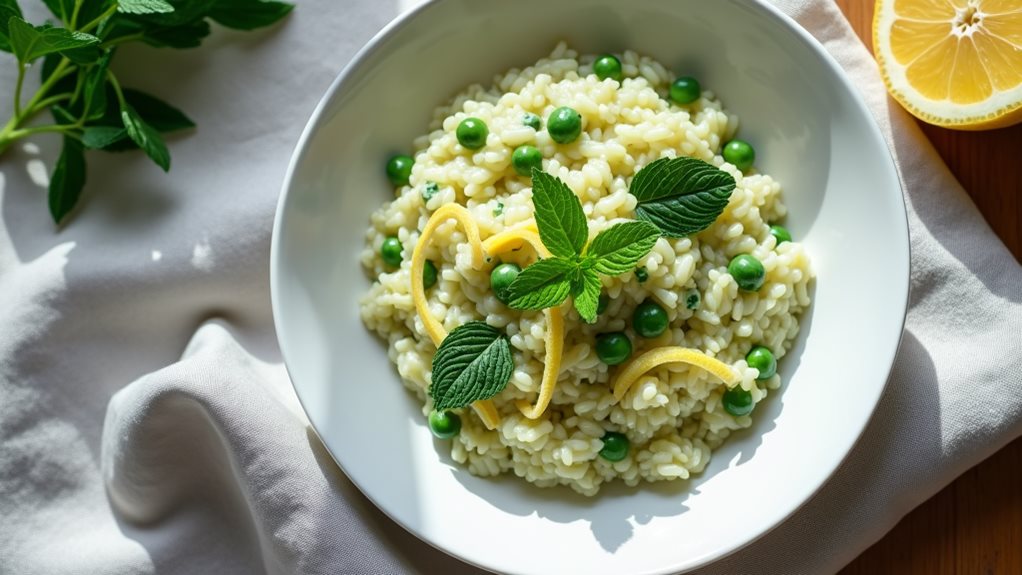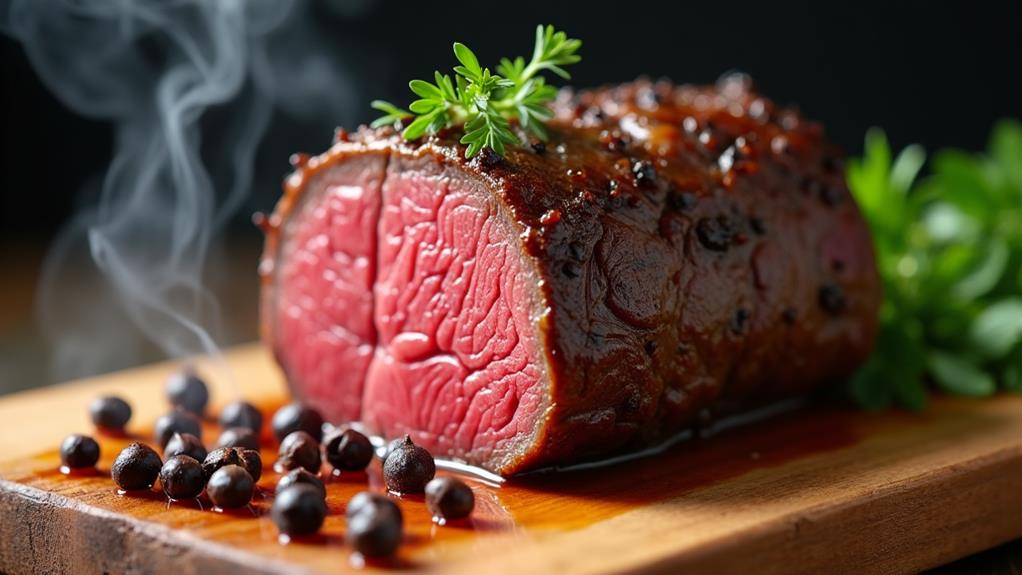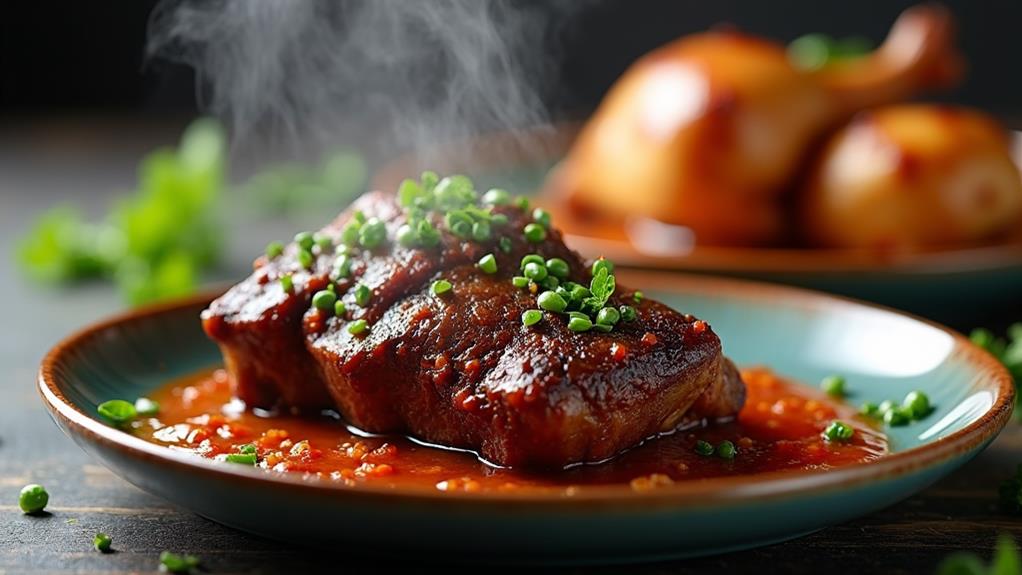Like the renaissance of spring itself, this vibrant risotto captures the essence of seasonal renewal on your plate. You'll discover how fresh peas, fragrant mint, and bright lemon transform a classic Italian dish into a celebration of springtime flavors. While traditional risotto may seem daunting, you're about to learn the secrets to creating this luxurious dish with confidence, mastering techniques that'll elevate your cooking repertoire far beyond this single recipe.
Key Takeaways
- Arborio rice is gradually cooked with hot stock while stirring constantly until creamy, forming the risotto's essential base.
- Fresh peas are added during the final 15 minutes of cooking, providing sweetness and seasonal spring flavor.
- Lemon zest and juice brighten the dish, while torn mint leaves add a refreshing herbaceous note.
- The entire cooking process takes about 20-25 minutes, with constant attention and stirring required.
- The finished risotto should be creamy yet al dente, with peas tender-crisp and aromatic from lemon and mint.
History
While risotto's exact origins remain debated among culinary historians, this creamy rice dish emerged in northern Italy during the 14th century, specifically in the Po Valley where rice cultivation flourished.
You'll find that rice arrived in Italy through trade with Arab merchants, who'd been cultivating it for centuries.
As you explore risotto's evolution, you'll discover that it became a staple of Milanese cuisine, where the addition of saffron created the famous "risotto alla Milanese."
The technique of slowly adding broth to rice while stirring wasn't documented until the 1800s, when it became the defining characteristic of what we now know as risotto.
Today's spring pea variation showcases how this historic dish continues to adapt, incorporating seasonal ingredients while maintaining its traditional cooking method.
Recipe
Spring Pea Risotto combines the creamy comfort of traditional Italian risotto with the fresh, vibrant flavors of spring. The marriage of sweet peas, bright lemon, and aromatic mint creates a dish that's both satisfying and refreshing.
This five-ingredient risotto proves that spectacular results can be achieved with minimal components. The key lies in the technique of slowly incorporating hot stock into the Arborio rice while stirring constantly, resulting in the signature creamy texture that makes risotto a beloved classic.
- 2 cups (400g) Arborio rice
- 6 cups (1.4L) vegetable or chicken stock
- 2 cups (300g) fresh or frozen peas
- 2 lemons, zested and juiced
- 1/2 cup (30g) fresh mint leaves, torn
Begin by bringing the stock to a simmer in a separate pot. Heat a large pan over medium heat and toast the rice for 2 minutes. Add hot stock one ladle at a time, stirring constantly and waiting for each addition to be absorbed before adding more.
After approximately 15 minutes, add the peas and continue adding stock until the rice is creamy and al dente, about 5-7 more minutes. Remove from heat and stir in the lemon zest, juice, and torn mint leaves.
The success of this dish depends on maintaining a steady temperature throughout the cooking process. Keep the stock hot, as adding cold liquid will interrupt the rice's cooking and affect the final texture.
The risotto should remain fluid – if it becomes too thick, add more hot stock. Resist the urge to rush; the gradual addition of liquid and constant stirring are essential for achieving the perfect creamy consistency. The rice should be tender but still have a slight bite in the center when done.
Cooking Steps
To make this classic risotto, you'll start by heating your stock to a simmer while simultaneously toasting the rice in a dry pan for two minutes.
Next, you'll begin the heart of the process by gradually adding hot stock to the rice, stirring constantly until each addition is absorbed before adding more.
Once you've been cooking for about 15 minutes, you'll incorporate the peas and continue adding stock until the rice reaches the perfect al dente texture, finishing with a bright burst of lemon and fresh mint.
Step 1. Heat Stock to Simmer
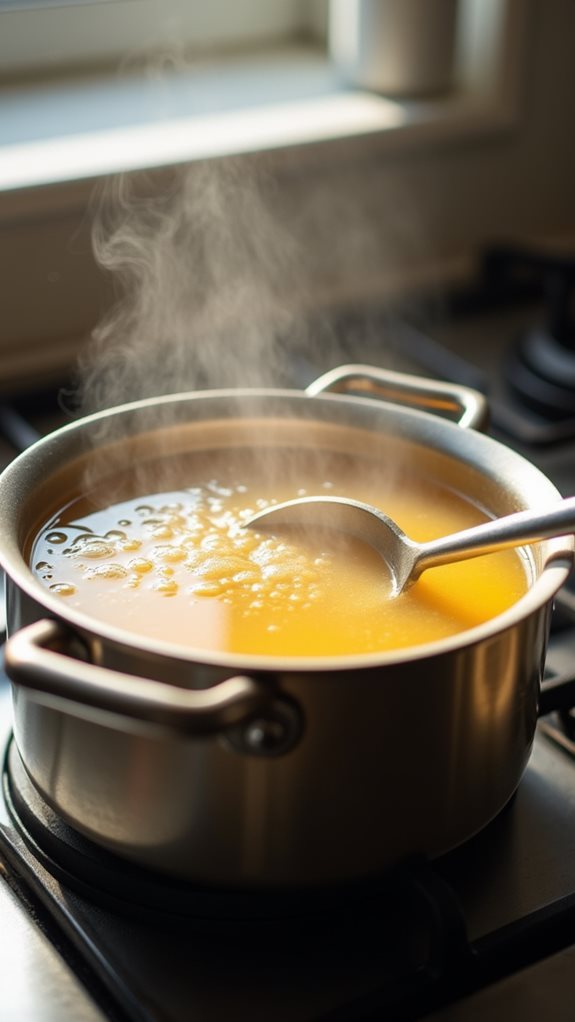
Begin your risotto preparation by bringing six cups of vegetable or chicken stock to a gentle simmer in a medium saucepan over medium-high heat.
You'll want to maintain this temperature throughout the cooking process, as the hot stock is crucial for proper rice absorption and the development of risotto's signature creamy texture.
Once you've achieved a gentle simmer, reduce the heat to medium-low to keep the stock hot without boiling.
You'll need to maintain this temperature as you gradually add the stock to your rice. If you notice the stock starting to boil, simply lower the heat – vigorous bubbling isn't necessary and could lead to excessive evaporation.
Step 2. Toast Rice in Dry Pan
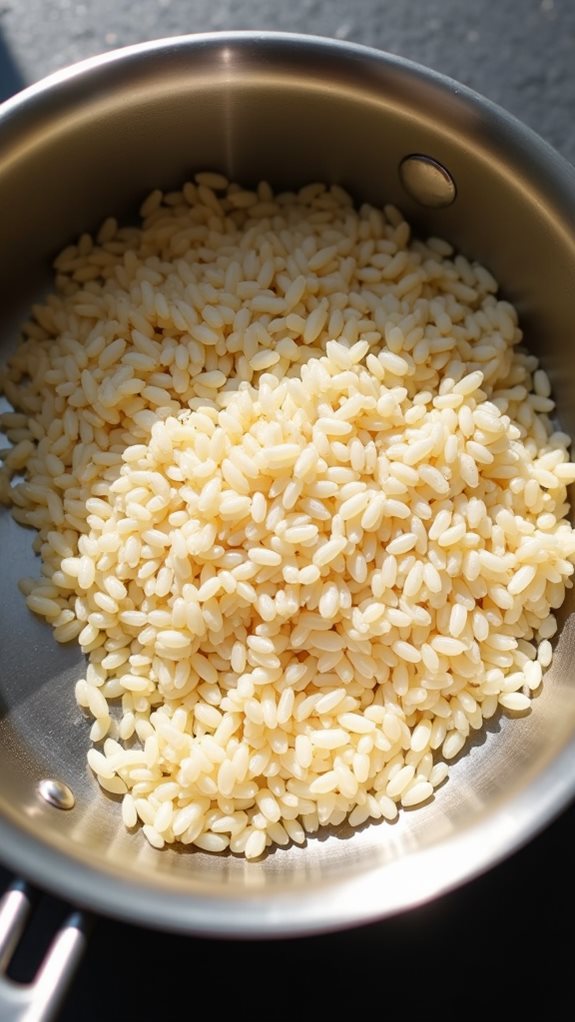
While your stock maintains its gentle simmer, place a large, heavy-bottomed pan over medium heat and prepare for the next key step in creating your risotto.
Add your Arborio rice to the dry, heated pan, and begin the crucial toasting process that'll enhance the rice's natural flavors and ensure proper texture development.
Move the rice continuously for about two minutes, listening for a subtle clicking sound as the grains make contact with the pan's surface.
You'll notice the edges of the rice becoming slightly translucent while the centers remain pearly white. This toasting step creates a protective coating around each grain, allowing it to slowly absorb liquid while maintaining its structure.
Don't let the rice brown – you're aiming for a gentle toast that prepares the rice for the stock-adding phase.
Step 3. Add Stock Gradually While Stirring
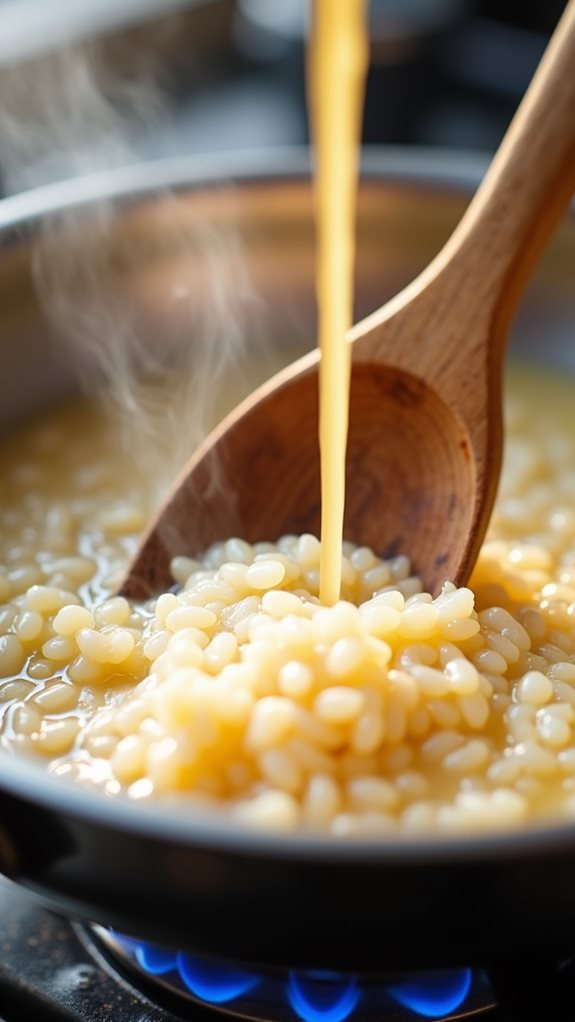
Now that your rice has been properly toasted, you'll begin the signature risotto technique of gradually adding hot stock while maintaining constant stirring motion.
Add one ladle of simmering stock to your rice, stirring continuously until the liquid is almost completely absorbed. You'll notice the rice beginning to release its starches, creating a creamy consistency.
Continue this process of adding stock one ladle at a time, always waiting for the previous addition to be mostly absorbed before adding more.
This gradual approach, combined with constant stirring, ensures the rice cooks evenly and develops the signature velvety texture that defines a proper risotto.
You'll need to maintain this rhythm for about 15 minutes, until it's time to incorporate the peas.
Step 4. Add Peas and Stir
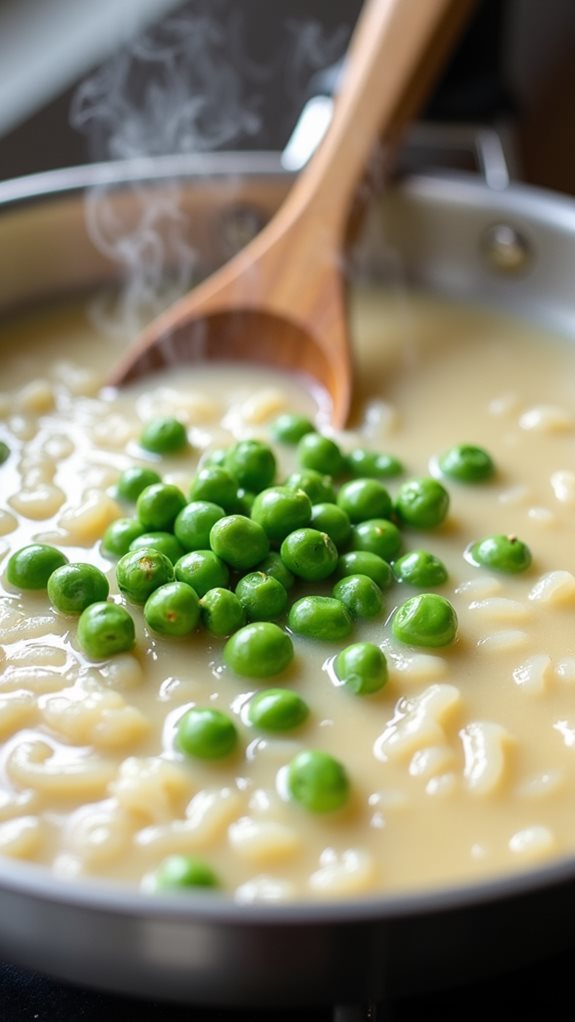
After approximately 15 minutes of cooking the rice, introduce the fresh or frozen peas into your risotto, maintaining the same stirring technique you've been using.
As you continue adding hot stock one ladle at a time, you'll notice the peas beginning to cook and soften, their bright green color enhancing the visual appeal of your dish.
Keep stirring gently but consistently, allowing each addition of stock to be absorbed before adding more.
The peas will cook perfectly in the time it takes to finish the risotto, about 5-7 more minutes.
You'll know they're done when they're tender but still retain a slight bite, complementing the al dente texture of the rice.
At this stage, your risotto should be creamy and flowing, with the peas evenly distributed throughout.
Step 5. Add Lemon and Mint
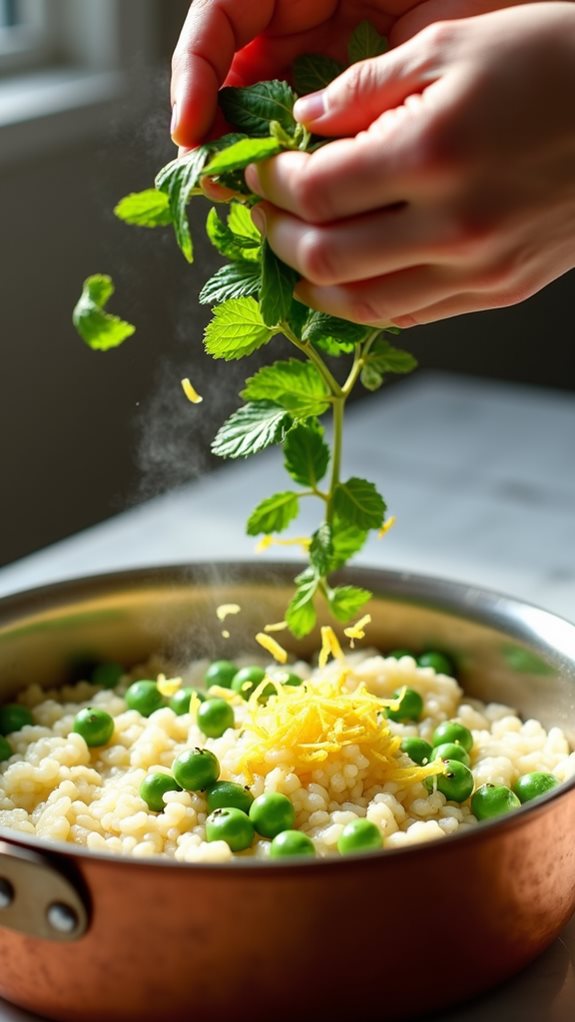
The finishing touches transform your risotto from good to extraordinary.
Once you've removed the pan from heat, it's time to add the bright, vibrant elements that'll elevate your dish. Zest your lemons directly over the risotto, being careful to avoid the bitter white pith, then squeeze in the fresh juice.
You'll want to tear the mint leaves into small pieces rather than chopping them, as this helps preserve their essential oils and intense flavor.
Stir these final ingredients gently but thoroughly into your risotto, allowing the residual heat to release their aromatic compounds. The lemon's acidity will cut through the rice's natural creaminess, while the mint adds a fresh, cooling note that perfectly complements the sweet peas.
Let the risotto rest for two minutes before serving to allow the flavors to meld together.
Final Thoughts
While making risotto requires patience and attention, mastering this spring pea version will reward you with a restaurant-quality dish that's both elegant and comforting.
You'll find that the combination of tender peas, bright lemon, and fresh mint creates a perfectly balanced plate that's ideal for any spring gathering or special dinner at home.
Don't let the steady stirring discourage you – it's actually a meditative process that helps you connect with your cooking.
Remember that you're in control of the final texture, so trust your instincts when adding stock and determining when the rice is done.
Once you've mastered this basic version, you can experiment with different seasonal vegetables and herbs to create your own signature risotto variations.

